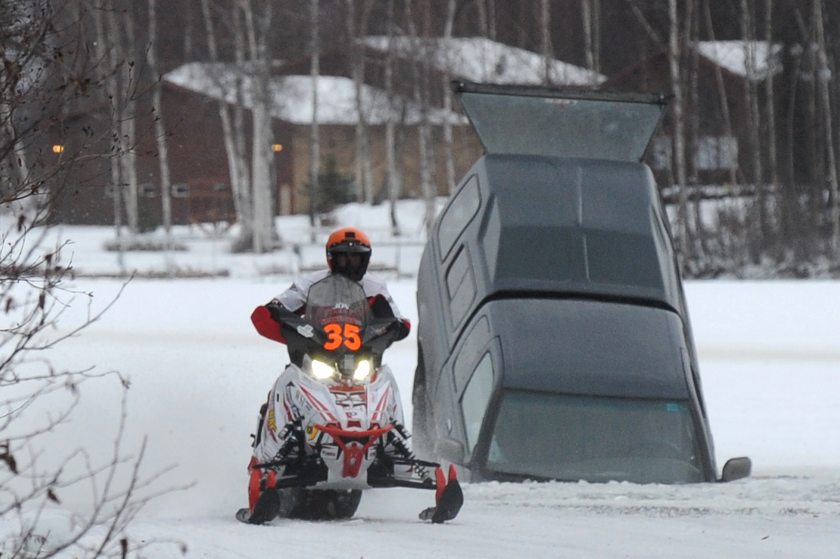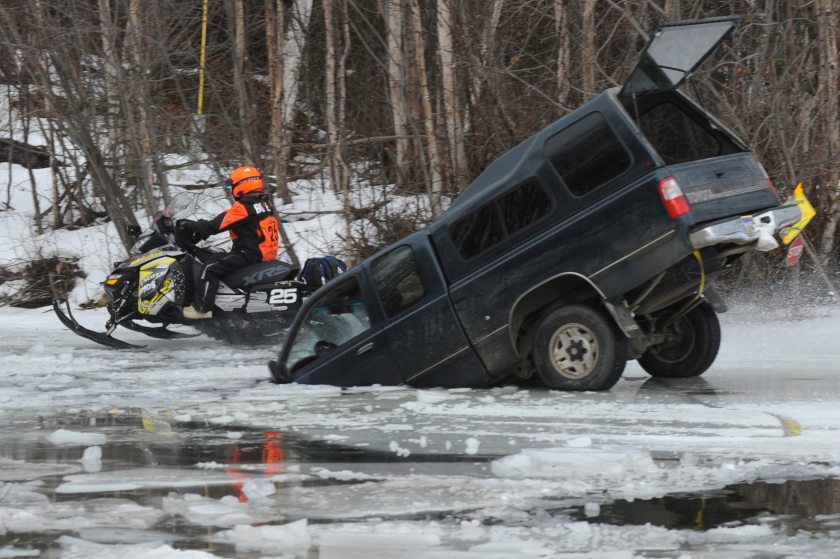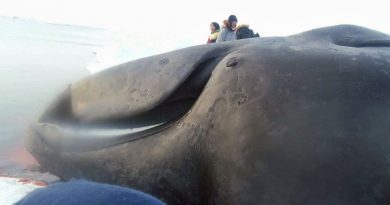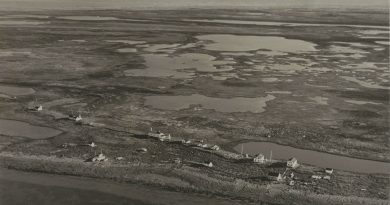Ice road truck woes: off-course pickups fall victim to Big Lake

WASILLA – Several pickups have broken through the ice of Big Lake since early January, as many as three in the past week alone.
Climate change might seem the likely scapegoat. But weather isn’t the primary reason, locals say. Instead, the problem is out-of-towners unfamiliar with the area and straying from the lake’s established ice roads.
The 6.5-mile (10.4 km) ice road provides access to hundreds of homes, many of them weekend cabins but also some year-round residences, on islands and shorelines of Big Lake, as well as Mud Lake and Flat Lake at the lake’s west end.
The most prominent pickup through the ice was a big blue truck with a topper that created a nose-down obstacle at the start of Sunday’s Iron Dog snowmachine race restart.
Three others also punched through, including a red extended-cab pickup that took the plunge just after New Year’s Day, according to Jeff Ross, who owns Floaters bar in Big Lake with his wife. The couple commute to work in winter via ice road from across the lake. The trip takes about seven minutes, basically a straight shot at about 55 mph.
“These people that are falling through the ice are going off of maintained ice roads,” Ross said. “If you just stay on these roads, you’re fine. Every time these guys have gone in, they’ve gone somewhere crazy.”

Big Lake isn’t the only place in the Valley to snare drivers who venture out on ill-advised ice trips. Recovery companies this winter also hauled a Jeep and a pickup out of partly frozen Rabbit Slough at Palmer Hay Flats State Game Refuge.
But Big Lake ice, at about three feet, is plenty thick, according to Dan Mayfield, a Matanuska-Susitna Borough assembly member from Big Lake who is also a longtime trail maintenance coordinator.
There is one weather component that could be leading to the break-throughs: this winter’s lack of snow has depleted the berms that normally line the volunteer-maintained ice roads, Mayfield said. Last weekend’s rain left the lake a blank sheet of ice.
Locals say they know enough to steer clear of the canal-like channel areas between Big Lake and Mud and Flat lakes where the trucks plunged through. Instead, the established road takes drivers up and onto land, around the channels, before returning to sound ice ahead.
“The channels, they just never freeze to the point where you can drive a vehicle on them,” said Mayfield.
Flat Lake homeowners even maintain a driver-shaming “through-the-ice” link on their website to track the latest indiscretions.
The driver who went in the drink at the start of January said he saw reflectors and “thought he could drive through it,” Carolyn Haggard wrote in an entry on the website. “NEVER drive through the channels. I don’t care if (it’s) 40 below.”
The reflective tape was left over from summer when residents marked the channel for boaters, Ross said.
There are signs urging drivers to stay on the established roads, but Mayfield said there’s little appetite for adding more signs despite the recent glut of trucks breaking through the ice.
“Folks are a little hesitant to put up more signs because we’ve already gotten a plethora of signs up here,” he said.
It’s hard to get a count of how many vehicles may sit at the lake bottom. Daniel Russell, who salvages sunk vehicles with his company Alaska Low Range Recovery, said there’s a plow truck down there that nobody could find.
“The driver wasn’t able to pinpoint the right location,” Russell said. “I don’t think anybody really tried that hard to get it out of there. They sink in the mud and go away.”
Related stories from around the North:
Canada: Driving on the ice road in Canada’s Northwest Territories, Eye on the Arctic
Finland: Winter speed limits coming into force in Finland, Yle News
Sweden: Test driving industry booming in Arctic Sweden, Radio Sweden
United States: Driving the sea ice, tundra in Arctic Alaska, Alaska Dispatch News



